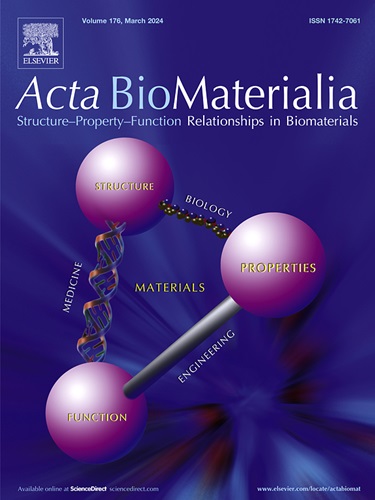Effect of binary mechanical environment on T cell function
IF 9.4
1区 医学
Q1 ENGINEERING, BIOMEDICAL
引用次数: 0
Abstract
T cells, key players in the immune system, recognize antigens via T-cell receptors (TCRs) and require additional costimulatory and cytokine signals for full activation. Beyond biochemical signals, T cells also respond to mechanical cues such as tissue stiffness. Traditional ex-vivo mechanostimulating platforms, however, present a uniform mechanical environment, unlike the heterogeneous conditions T cells encounter in-vivo. This work introduces a mechanically-biphasic T-cell stimulating surface, with alternating soft and stiff microdomains, to mimic the complex mechanical signals T cells face. Results show that T cells exposed to this biphasic environment do not average the mechanical signals but instead respond similarly to those on a homogeneously soft surface, leading to lower activation compared to those on a stiff surface. Interestingly, long-term exposure to these patterns enhances the proliferation of central memory and effector T cell phenotypes, similar to stiff environments. These findings reveal the non-linear nature of T cell mechanosensing and suggest that mechanical heterogeneity plays a critical role in modulating T cell responses, providing new insights into T cell activation and potential implications for immunotherapies.
Statement of significance
This research offers a fresh perspective in T cell mehanosensing, an important yet underexplored aspect of immunity. While previous studies have demonstrated that T cells sense homogeneous mechanical environments ex-vivo, their ability to discern and respond to simultaneous mechanical cues–resembling the complexity of in-vivo conditions–remained unexamined. By designing a mechanically patterned surface with alternating soft and stiff microdomains, this study simulates the diverse mechanical landscape encountered by T cells in-vivo. The findings reveal that T cells predominantly respond to this pattern as they would to a uniformly soft environment. This insight, showing that mechanical signals shape T cell activation and promote specific phenotypes, enhances our understanding of T cell biology and points to new directions for immunotherapy development.

求助全文
约1分钟内获得全文
求助全文
来源期刊

Acta Biomaterialia
工程技术-材料科学:生物材料
CiteScore
16.80
自引率
3.10%
发文量
776
审稿时长
30 days
期刊介绍:
Acta Biomaterialia is a monthly peer-reviewed scientific journal published by Elsevier. The journal was established in January 2005. The editor-in-chief is W.R. Wagner (University of Pittsburgh). The journal covers research in biomaterials science, including the interrelationship of biomaterial structure and function from macroscale to nanoscale. Topical coverage includes biomedical and biocompatible materials.
 求助内容:
求助内容: 应助结果提醒方式:
应助结果提醒方式:


